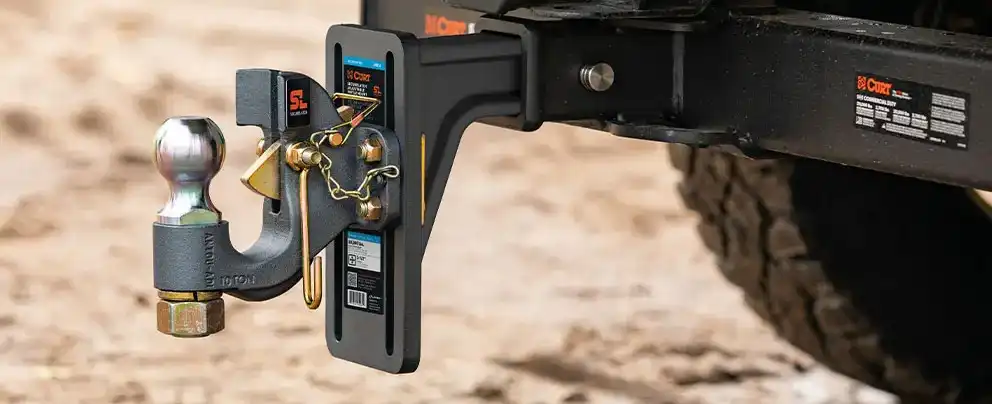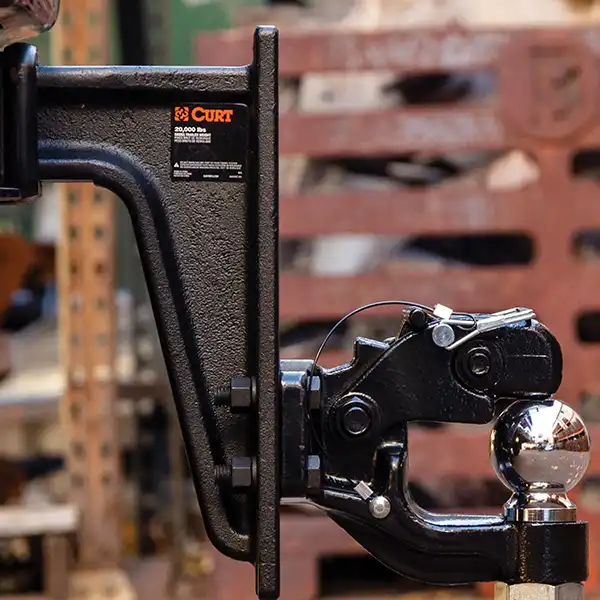Are you ready to hit the road with confidence, trailer in tow? Mastering the art of secure towing is essential for any truck owner – pintle hitch. Whether you’re hauling a camper for a weekend getaway or transporting equipment for work, knowing the ins and outs of safe towing can make all the difference.
The Importance of Secure Towing
Did you know that over 70% of truck owners use their vehicles for towing purposes? That’s right, towing isn’t just for commercial purposes anymore. From DIY enthusiasts to small business owners, towing plays a significant role in many people’s lives. But with great towing power comes great responsibility. Ensuring your load is secure not only protects your cargo but also keeps you and other drivers safe on the road.
Pintle Hitch: The Unsung Hero of Towing
Enter the pintle hitch, the unsung hero of towing setups. While it may not get as much attention as its ball hitch counterpart, the pintle hitch offers unparalleled strength and versatility. Its simple yet robust design makes it ideal for heavy-duty towing applications, whether you’re hauling construction materials or pulling a horse trailer.
With a pintle hitch, you can say goodbye to the limitations of traditional ball hitches. Its swivel design allows for greater articulation, making it easier to navigate tight turns and rough terrain. Plus, its higher weight capacity means you can tow heavier loads with confidence.

Choosing the Right Hitch for the Job
When it comes to selecting the right hitch for your towing needs, there are a few factors to consider. First and foremost is compatibility. Make sure your pintle hitch is compatible with your truck’s towing capacity and the weight of your trailer.
Next, consider the type of terrain you’ll be traversing. If you’ll be tackling rugged off-road trails, opt for a pintle hitch with a locking mechanism to prevent excessive movement. On the other hand, if you’ll be sticking to paved roads, a standard pintle hitch should suffice.
Finally, don’t forget about maintenance. Just like any other component of your truck, your pintle hitch requires regular upkeep to ensure optimal performance. Be sure to inspect it for signs of wear and tear before each towing excursion and lubricate it as needed to prevent rust and corrosion.

Tips for Safe Towing
Now that you’ve got your pintle hitch installed and ready to go, it’s time to hit the road. But before you do, here are a few tips to ensure a safe and smooth towing experience:
- Distribute the Weight: Proper weight distribution is key to maintaining stability while towing. Make sure your cargo is evenly distributed and secured to prevent swaying and fishtailing.
- Check Your Lights: Before setting off, double-check that all of your trailer lights are working properly. This includes brake lights, turn signals, and hazard lights. Good visibility is crucial for safe towing, especially at night or in inclement weather.
- Mind Your Speed: While it may be tempting to put the pedal to the metal, speeding while towing can be extremely dangerous. Stick to the posted speed limits and adjust your speed accordingly based on road and weather conditions.
- Give Yourself Room: Remember, you’re not driving a sports car anymore. Give yourself plenty of room to accelerate, brake, and maneuver, especially when towing a heavy load.
- Take It Slow: When towing, slow and steady wins the race. Avoid sudden movements and take corners and turns at a controlled pace to prevent jackknifing or tipping.

Elevate Your Towing Game with Advanced Pintle Hitch Techniques
So, you’ve mastered the basics of towing with a pintle hitch. But why stop there when there’s a whole world of advanced techniques waiting to be explored? Let’s dive into some advanced pintle hitch techniques that will take your towing game to the next level.
Maneuvering Like a Pro
Towing with a pintle hitch already offers superior maneuverability, but did you know there are ways to enhance it even further? One advanced technique is the use of a pintle hook adapter, which allows for greater articulation and tighter turns. With this handy accessory, you’ll be able to navigate even the trickiest of corners with ease.
Another technique to master is the art of backing up with a pintle hitch. While it may seem daunting at first, practice makes perfect. Start by practicing in an empty parking lot or a wide-open space, gradually honing your skills until you can confidently maneuver your trailer in reverse without breaking a sweat.

Maximizing Stability and Control
When it comes to towing, stability and control are paramount. Fortunately, there are several advanced techniques you can employ to maximize both. One such technique is the use of sway control devices, which help minimize trailer sway caused by crosswinds, passing vehicles, or uneven road surfaces.
Additionally, investing in a weight distribution hitch can help evenly distribute the weight of your trailer across all axles, reducing the strain on your vehicle and improving overall stability. Combined with a pintle hitch, these advanced accessories can make for a smoother, more controlled towing experience.
Safety First: Advanced Hitch Maintenance
As with any towing setup, proper maintenance is key to ensuring both safety and longevity. However, when it comes to advanced pintle hitch techniques, there are a few additional maintenance tasks to keep in mind. Regularly inspecting the pintle hitch itself for signs of wear and tear is crucial, as is lubricating any moving parts to prevent rust and corrosion.
Furthermore, don’t forget to check the condition of your pintle hook adapter and any other accessories you may be using. Replace any worn or damaged components promptly to avoid compromising the integrity of your towing setup. By staying on top of maintenance tasks, you’ll not only prolong the life of your equipment but also enjoy peace of mind knowing that your towing rig is in top-notch condition.

Ensuring Your Hitch Setup is Safe and Secure
You’re all set to hit the road with your trailer hitched up, but before you go, it’s essential to ensure your hitch setup is safe and secure. Neglecting safety checks can lead to disaster on the road, and you definitely don’t want that. Let’s dive into some essential safety checks you should perform before towing with your pintle hitch.
The Importance of Hitch Safety
Did you know that nearly 40% of truck owners make mistakes with their hitch setup that compromise safety? Don’t be part of that statistic! Taking the time to perform thorough safety checks can prevent accidents and ensure a smooth towing experience.
Inspecting Your Hitch Components
The first step in ensuring hitch safety is to inspect all components of your setup thoroughly. Check for any signs of wear or damage, such as cracks, rust, or bent parts. Pay close attention to the pintle hitch itself, as well as any accessories like pintle hook adapters or sway control devices.
Next, make sure all bolts and fasteners are tightened securely. Loose bolts can cause your hitch setup to shift or detach while towing, leading to dangerous situations on the road. A quick once-over with a wrench can save you a lot of headaches down the line.

Checking Trailer Coupling
Once you’ve inspected the hitch components, it’s time to check the coupling between your trailer and your vehicle. Ensure that the trailer coupler is properly seated on the pintle hitch and that the locking mechanism is engaged securely. Give it a firm tug to confirm that it’s latched in place.
Additionally, check the safety chains and emergency breakaway cable. These serve as backups in case the trailer becomes detached from the vehicle, so it’s crucial that they’re in good condition and properly connected.
Testing Lights and Signals
Good visibility is essential for safe towing, so don’t forget to check all of your trailer lights and signals before hitting the road. Test the brake lights, turn signals, and hazard lights to ensure they’re working correctly. If any bulbs are burnt out or lenses are cracked, replace them before setting off.
It’s also a good idea to have someone stand behind your trailer while you activate the lights to confirm that they’re functioning properly. This extra set of eyes can help identify any issues you may have missed during your inspection.

Navigating Hitch Hiccups: Troubleshooting Common Issues
So, you’re all geared up for your towing adventure, but suddenly, you hit a snag – quite literally. Don’t worry; we’ve got you covered! Let’s troubleshoot some common hitch issues you may encounter with your pintle hitch setup.
Dealing with Misalignment
Ever struggled to get your trailer hitched up straight? Misalignment can be a real headache, but fear not – there’s a simple solution. Try adjusting the height of your pintle hitch to ensure it lines up perfectly with the trailer coupler. A little patience and finesse can go a long way in achieving a smooth connection.
Addressing Excessive Sway
If you find your trailer swaying excessively while towing, it’s time to get to the root of the problem. Excessive sway can be caused by several factors, including uneven weight distribution or inadequate sway control. Start by redistributing the weight of your cargo evenly and ensuring that your sway control devices are properly installed and adjusted.
Additionally, consider reducing your speed, especially when navigating curves or windy conditions. Slowing down can help mitigate sway and give you better control over your towing setup.

Resolving Hitch Binding
Hitch binding occurs when the pintle hitch and trailer coupler become jammed together, making it difficult to unhitch your trailer. This frustrating issue can often be attributed to rust, corrosion, or debris buildup in the hitch mechanism.
To resolve hitch binding, try lubricating the pintle hitch and trailer coupler with a high-quality lubricant. Be sure to clean away any debris or rust beforehand to ensure smooth operation. If the problem persists, you may need to inspect the hitch components for signs of damage and make any necessary repairs or replacements.
Troubleshooting Electrical Problems
Electrical issues can also plague your towing setup, particularly when it comes to trailer lights and signals. If you’re experiencing problems with your trailer lights not working properly, start by checking the connections and wiring for any signs of damage or corrosion.
Next, test the vehicle’s electrical system to ensure it’s supplying power to the trailer properly. A faulty fuse or wiring harness could be to blame for the problem. If all else fails, consult a professional to diagnose and repair any electrical issues with your towing setup.

